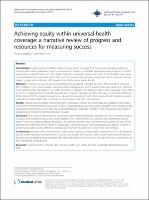| dc.description.abstract | Introduction: Equity should be implicit within universal health coverage (UHC) however, emerging evidence is showing that without adequate focus on measurement of equity, vulnerable populations may continue to receive inadequate or inferior health care. This study undertakes a narrative review which aims to: (i) elucidate how equity is contextualised and measured within UHC, and (ii) describe tools, resources and lessons which will assist decision makers to plan and implement UHC programmes which ensure equity for all. Methods: A narrative review of peer-reviewed literature published in English between 2005 and 2013, retrieved from PubMed via the search words, ‘universal health coverage/care’ and ‘equity/inequity’ was performed. Websites of key global health organizations were also searched for relevant grey literature. Papers were excluded if they failed to focus on equity (of access, financial risk protection or health outcomes) as well as focusing on one of the following: (i) the impact of UHC programmes, policies or interventions on equity (ii) indicators, measurement, monitoring and/or evaluation of equity within UHC, or (iii) tools or resources to assist with measurement. Results: Eighteen journal articles consisting mostly of secondary analysis of country data and qualitative case studies in the form of commentaries/reviews, and 13 items of grey literature, consisting largely of reports from working groups and expert meetings focusing on defining, understanding and measuring inequity in UHC (including recent drafts of global/country monitoring frameworks) were included. Discussion: The literature advocates for progressive universalism addressing monetary and non-monetary barriers to access and strengthening existing health systems. This however relies on countries being effectively able to identify and reach disadvantaged populations and estimate unmet need. Countries should assess the new WHO/ WB-proposed framework for its ability to adequately track the progress of disadvantaged populations in terms of achieving equitable access, effective coverage and financial risk protection within their own settings. Conclusions: Recently published resources contextualise equity as a measurable component of UHC and propose several useful indicators and frameworks. Country case-studies also provide useful lessons and recommendations for planning and implementing equitable UHC which will assist other countries to consider their own requirements for UHC monitoring and evaluation. | |

